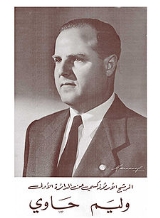
William Hawi
Encyclopedia
William Amine Hawi — (September 5, 1908 – July 13, 1976), William Hawi joined the Kataeb Social Democratic Party in 1937 better known in English
as the Phalangist party organization, a right-wing political party in Lebanon
.
He was appointed Head of the Second and Fourth Districts, President of the Recruitment Bureau, Head of the Department of Security, Sport and Mobilization on May 29, 1952, and member of the Political Bureau on July 12, 1952. On June 16, 1958, William Hawi was in charge of organizing and leading the activists during the Lebanese events; this constituted the hub of the Party's Regulatory Forces. On January 23, 1961, the Political Bureau dissolved the militants' organization before including its members in the Lebanese Phalange Party and Hawi created the Regulatory Forces. On February 6, 1961, William Hawi was appointed Head of said Forces. In 1963, the “First Commandos” unit was created. It was followed by the “Second Commandos” unit, then by the “P.G.” troop. In 1973, the "Maghaweer" platoon was created and the “Combat School” established. Moreover, “Chef” William supervised the setting up of camps as well as the training organization and development, which enabled the progress of the regulatory process.
In 1952, the Lebanese
Phalange put William Hawi up for the Beirut
Municipal Council in the Achrafieh
-Rmeil region, where he obtained the largest number of votes. In 1957, Hawi presented himself to the legislative elections but failed.
In 1975, Hawi was leading defense operations against the Palestinian attacks on the Souks of Beirut, Karantina
, Jisr el Basha, Dekwaneh
, Galerie Semaan and what is known as the "Hotels fight".
On July 1, 1976, the sources of the Lebanese allied forces announced the fall of the last bastion in Tel el-Zaatarhttp://www.liberty05.com/civilwar/civil1.html and declared that the Head of the Phalange War Council supervised this operation.
On July 13, 1976, William Hawi was killed in the middle of the battlefield in Tel el-Zaatarhttp://www.liberty05.com/civilwar/civil1.html with a bullet in the forehead. Upon his death, Bashir Gemayel was appointed his replacement as president of the Kataeb Military Council, which later became the core of the Lebanese Forces
.
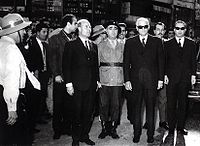 William Hawi’s family comes from the village of Choueir in North Metn, Lebanon
William Hawi’s family comes from the village of Choueir in North Metn, Lebanon
. William’s father, Amine Hawi, emigrated when he was twenty years old. His second son, William, was born in New York
, U.S.
in 1908. Before the family grew and spread its roots in the foreign land, Amine Hawi went back to his homeland in the beginning of 1910, along with his wife and three children. William Hawi had a passion for sports. He played football, tennis
and loved swimming and skiing
. His sports activities were topped by his participation in the creation of Al Salam Club in Achrafieh
. William Hawi met Pierre Gemayel
in sports meetings and the latter invited him in 1937 to join the Lebanese
Phalange Organization .
In 1947, William Hawi married Marcelle Anis Ghobril. They lived in Beydoun quarter in Achrafieh
and had a single daughter, Leila.
William Hawi owned a factory of mirrors, which exported its products to the Arab countries and became one of the most important factories in the Middle East
before moving from Debbas Square to Jisr el Basha . With the Palestinian-Lebanese war in 1970, the region of Jisr el Basha fell under the control of the Palestinians living in the camps of Jisr el Basha and Tell el Zaatar and the factory became a primary target for destruction as revenge against its owner: William Hawi, leader of the Lebanese parties opposed to the Palestinian intervention in Lebanese affairs. The Palestinians broke into the factory, destroyed glass and machines before blowing up the facility.
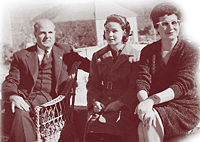 William Hawi accepted Pierre Gemayel
William Hawi accepted Pierre Gemayel
’s invitation and joined the Phalange Organization in 1937 even when it was working secretly and illegally following a decree ordering its dissolution in 18 November 1938 . He was involved in several issues: consolidating the Party's authority and creating and developing the Kataeb Regulatory Forces
in an atmosphere of discipline. William Hawi’s responsibilities increased and became diversified. He was appointed Head of the Second and Fourth Districts, President of the Recruitment Bureau in 1942, Head of the 'Department of Security, Sport and Mobilization' on May 29, 1952 , and member of the Political Bureau on July 12, 1952. On June 16, 1958, he was in charge of organizing and leading the activists during the Lebanese events; this constituted the hub of the Party's Regulatory Forces, of which he became the leader on February 6, 1961.
The discussions about creating the Phalange Security wing featured several conflicting opinions and lasted interminably before the Party took its final decision to agree to the presence of Regulatory Forces. On January 23, 1961, the Political Bureau dissolved the militants' organization before including its members in the Lebanese Phalange Party and Hawi created the Kataeb Regulatory Forces
. On February 6, 1961, William Hawi was appointed Head of said Forces. In 1963, the “First Commandos” unit was created . It was followed by the “Second Commandos” unit, then by the “P.G.” troop. In 1973, the "Maghaweer" platoon was created and the “Combat School” established. Moreover, “Chef” William supervised the setting up of camps as well as the training organization and development.
prisoner, Joseph Shader took over the political command while William Hawi was in charge of the organized security effort. He prepared and organized the strikes and demonstrations. He held secret meetings with the Najjadeh Party
("the rescuers") at the mirror factory he owned in Debbas Square. When the French found out about these meetings, they raided the factory several times and pursued William Hawi who escaped by hiding at his friends and neighbors.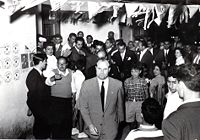 In 1952, the Lebanese Phalange put William Hawi up for the Beirut
In 1952, the Lebanese Phalange put William Hawi up for the Beirut
Municipal Council in the Achrafieh
-Rmeil region for the Christian Grec Orthodox seat, where he obtained the largest number of votes. In 1957, he individually ran for the Parliamentary elections opposite Ghassan Tueini and Nassim Majdalani but did not win. Despite its loss, the Phalange Party considered these elections to be a confirmation of its strength on the streets.
During this period, the Lebanese and Arab scenes were marked by the halo of the Egyptian President
, Gamal Abdel Nasser
. The Phalange Party was fiercely opposed to the pro-Nasser movement
that called for strikes and organized riots. It thus entrusted William Hawi with organizing and leading the activists to control the situation and protect its regions.
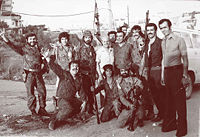 Events started escalating dramatically in favor of the Palestinians who started infiltrating the safe houses in the cities and villages, raising confusion and violating rights and properties.The Political Bureau held an extraordinary meeting on March 31, 1970 and created a “Higher Council” in charge of supervising the organization of the Party’s work relating to its security and that of the country. William Hawi was entrusted with the security issues and requirements. While the political command of the Party was trying to establish peace and dialogue, the military command led by William Hawi was preparing the Regulatory Forces, manning its human and material capacities in order to fight against the settlement plan that had already started to emerge. The state being unable to fulfill its duties and defend its people, and the governmental institutions being disabled, it was necessary to unify and organize the ranks of the parties for defense purposes. William Hawi was worried by the lack of weapons, ammunitions and supplies and by the absence of coordination between the allied Lebanese forces at the front. He held several meetings with the allied forces in order to create a "Unified Operation Room”, the first core of the “Lebanese Forces
Events started escalating dramatically in favor of the Palestinians who started infiltrating the safe houses in the cities and villages, raising confusion and violating rights and properties.The Political Bureau held an extraordinary meeting on March 31, 1970 and created a “Higher Council” in charge of supervising the organization of the Party’s work relating to its security and that of the country. William Hawi was entrusted with the security issues and requirements. While the political command of the Party was trying to establish peace and dialogue, the military command led by William Hawi was preparing the Regulatory Forces, manning its human and material capacities in order to fight against the settlement plan that had already started to emerge. The state being unable to fulfill its duties and defend its people, and the governmental institutions being disabled, it was necessary to unify and organize the ranks of the parties for defense purposes. William Hawi was worried by the lack of weapons, ammunitions and supplies and by the absence of coordination between the allied Lebanese forces at the front. He held several meetings with the allied forces in order to create a "Unified Operation Room”, the first core of the “Lebanese Forces
”.
William Hawi created a “Military Police” in charge of controlling the disorder and chaos that were everywhere and introduced a regulatory mechanism to guarantee road safety and guide the citizens to these safe roads. Perhaps the most terrible ordeal he had to face was that famous massacre on December 6, 1975, that was later called the “Black Saturday
” where he was also subjected to menaces and humiliation when he tried to rescue as many innocents as he could. Several persons owe him their lives, their dignity and their properties.
William Hawi engaged in a fight against corruption and in a battle for liberation when the Palestinians tried to control Beirut
completely by isolating it with their surrounding military camps. The Quarantine camp fell within 24 hours under the attack orchestrated by William Hawi, which opened the road linking Beirut to Kesserouan and Jbeil in December 1976. The camp of Jisr el Basha also fell after two days of the blockade organized by “Chef” William, paving the way for the liberation of the camp of Tell el Zaatarhttp://www.liberty05.com/civilwar/civil1.html. However, the camp fell one building after the other. On July 11, 1976, the sources of the Lebanese allied forces announced the fall of the last bastion in Tell el Zaatar and declared that the Head of the Phalange War Council supervised this operation. On July 13, 1976, William Hawi was killed in the middle of the battlefield, before having the opportunity to celebrate his victory.
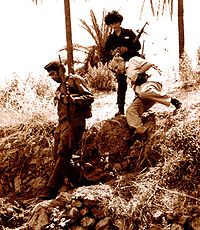 On July 13, 1976, at the boundaries of Tell el Zaatar http://www.liberty05.com/civilwar/civil1.html, between Al Raii El Saleh and Gallery Matta, a shot was fired by a sniper and killed Hawi while he inspected his forces at the forefront of the battlefield as witnessed by his comrades who were with him.
On July 13, 1976, at the boundaries of Tell el Zaatar http://www.liberty05.com/civilwar/civil1.html, between Al Raii El Saleh and Gallery Matta, a shot was fired by a sniper and killed Hawi while he inspected his forces at the forefront of the battlefield as witnessed by his comrades who were with him.
Upon the death of William Hawi, Bashir Gemayel was appointed his replacement as president of the Kataeb Military Council http://www.lebaneseforces.com/bachirbiography.asp and as the head of the unified command of the Lebanese forces, a coalition of the Christian militias of the Kataeb Party (created and organized by Hawi), National Liberal Party, the Tanzim and the Guardians of the Cedars. On July 7, 1980, these Christian militias were unified into one as the Lebanese Forces
with Bashir Gemayel as their Commander-in-Chief. http://www.lebaneseforces.com/bachirlffounder.asp
Gemayel was elected as president on August 24, 1982, but he was assassinated on September 14, 1982, before the beginning of his term.
The Lebanese Forces
in addition to the Kataeb party are major forces in the current Lebanese March 14th Forces
coalition at the heart of the present Lebanon conflict, Rafic Hariri UN probe / tribunal, and the on-going protests in down-town Beirut.
English language
English is a West Germanic language that arose in the Anglo-Saxon kingdoms of England and spread into what was to become south-east Scotland under the influence of the Anglian medieval kingdom of Northumbria...
as the Phalangist party organization, a right-wing political party in Lebanon
Lebanon
Lebanon , officially the Republic of LebanonRepublic of Lebanon is the most common term used by Lebanese government agencies. The term Lebanese Republic, a literal translation of the official Arabic and French names that is not used in today's world. Arabic is the most common language spoken among...
.
He was appointed Head of the Second and Fourth Districts, President of the Recruitment Bureau, Head of the Department of Security, Sport and Mobilization on May 29, 1952, and member of the Political Bureau on July 12, 1952. On June 16, 1958, William Hawi was in charge of organizing and leading the activists during the Lebanese events; this constituted the hub of the Party's Regulatory Forces. On January 23, 1961, the Political Bureau dissolved the militants' organization before including its members in the Lebanese Phalange Party and Hawi created the Regulatory Forces. On February 6, 1961, William Hawi was appointed Head of said Forces. In 1963, the “First Commandos” unit was created. It was followed by the “Second Commandos” unit, then by the “P.G.” troop. In 1973, the "Maghaweer" platoon was created and the “Combat School” established. Moreover, “Chef” William supervised the setting up of camps as well as the training organization and development, which enabled the progress of the regulatory process.
In 1952, the Lebanese
Lebanon
Lebanon , officially the Republic of LebanonRepublic of Lebanon is the most common term used by Lebanese government agencies. The term Lebanese Republic, a literal translation of the official Arabic and French names that is not used in today's world. Arabic is the most common language spoken among...
Phalange put William Hawi up for the Beirut
Beirut
Beirut is the capital and largest city of Lebanon, with a population ranging from 1 million to more than 2 million . Located on a peninsula at the midpoint of Lebanon's Mediterranean coastline, it serves as the country's largest and main seaport, and also forms the Beirut Metropolitan...
Municipal Council in the Achrafieh
Achrafieh
Achrafieh, , is one of the oldest Christian districts of East Beirut, Lebanon.-Overview:It is located on a hill in the eastern part of Beirut alongside the shore. Achrafieh is both a residential and commercial district characterized by narrow winding streets and prestigious large apartment and...
-Rmeil region, where he obtained the largest number of votes. In 1957, Hawi presented himself to the legislative elections but failed.
In 1975, Hawi was leading defense operations against the Palestinian attacks on the Souks of Beirut, Karantina
Karantina
La Quarantaine, which is colloquially referred to as Karantina and sometimes spelled Quarantina, is a predominately low-income, mixed-use residential, commercial, and semi-industrial neighborhood in northeastern Beirut...
, Jisr el Basha, Dekwaneh
Dekwaneh
Dekwaneh is a suburb north of Beirut in the Matn District of the Mount Lebanon Governorate, Lebanon. The population is predominantly Marionite Christian...
, Galerie Semaan and what is known as the "Hotels fight".
On July 1, 1976, the sources of the Lebanese allied forces announced the fall of the last bastion in Tel el-Zaatarhttp://www.liberty05.com/civilwar/civil1.html and declared that the Head of the Phalange War Council supervised this operation.
On July 13, 1976, William Hawi was killed in the middle of the battlefield in Tel el-Zaatarhttp://www.liberty05.com/civilwar/civil1.html with a bullet in the forehead. Upon his death, Bashir Gemayel was appointed his replacement as president of the Kataeb Military Council, which later became the core of the Lebanese Forces
Lebanese Forces
The Lebanese Forces is a Lebanese political party. Founded as a militia by Bachir Gemayel during the Lebanese Civil War, the movement fought as the main militia within the Christian-dominated Lebanese Front...
.
Background

Lebanon
Lebanon , officially the Republic of LebanonRepublic of Lebanon is the most common term used by Lebanese government agencies. The term Lebanese Republic, a literal translation of the official Arabic and French names that is not used in today's world. Arabic is the most common language spoken among...
. William’s father, Amine Hawi, emigrated when he was twenty years old. His second son, William, was born in New York
New York
New York is a state in the Northeastern region of the United States. It is the nation's third most populous state. New York is bordered by New Jersey and Pennsylvania to the south, and by Connecticut, Massachusetts and Vermont to the east...
, U.S.
United States
The United States of America is a federal constitutional republic comprising fifty states and a federal district...
in 1908. Before the family grew and spread its roots in the foreign land, Amine Hawi went back to his homeland in the beginning of 1910, along with his wife and three children. William Hawi had a passion for sports. He played football, tennis
Tennis
Tennis is a sport usually played between two players or between two teams of two players each . Each player uses a racket that is strung to strike a hollow rubber ball covered with felt over a net into the opponent's court. Tennis is an Olympic sport and is played at all levels of society at all...
and loved swimming and skiing
Skiing
Skiing is a recreational activity using skis as equipment for traveling over snow. Skis are used in conjunction with boots that connect to the ski with use of a binding....
. His sports activities were topped by his participation in the creation of Al Salam Club in Achrafieh
Achrafieh
Achrafieh, , is one of the oldest Christian districts of East Beirut, Lebanon.-Overview:It is located on a hill in the eastern part of Beirut alongside the shore. Achrafieh is both a residential and commercial district characterized by narrow winding streets and prestigious large apartment and...
. William Hawi met Pierre Gemayel
Pierre Gemayel
Sheikh Pierre Gemayel , was a Lebanese political leader...
in sports meetings and the latter invited him in 1937 to join the Lebanese
Lebanon
Lebanon , officially the Republic of LebanonRepublic of Lebanon is the most common term used by Lebanese government agencies. The term Lebanese Republic, a literal translation of the official Arabic and French names that is not used in today's world. Arabic is the most common language spoken among...
Phalange Organization .
In 1947, William Hawi married Marcelle Anis Ghobril. They lived in Beydoun quarter in Achrafieh
Achrafieh
Achrafieh, , is one of the oldest Christian districts of East Beirut, Lebanon.-Overview:It is located on a hill in the eastern part of Beirut alongside the shore. Achrafieh is both a residential and commercial district characterized by narrow winding streets and prestigious large apartment and...
and had a single daughter, Leila.
William Hawi owned a factory of mirrors, which exported its products to the Arab countries and became one of the most important factories in the Middle East
Middle East
The Middle East is a region that encompasses Western Asia and Northern Africa. It is often used as a synonym for Near East, in opposition to Far East...
before moving from Debbas Square to Jisr el Basha . With the Palestinian-Lebanese war in 1970, the region of Jisr el Basha fell under the control of the Palestinians living in the camps of Jisr el Basha and Tell el Zaatar and the factory became a primary target for destruction as revenge against its owner: William Hawi, leader of the Lebanese parties opposed to the Palestinian intervention in Lebanese affairs. The Palestinians broke into the factory, destroyed glass and machines before blowing up the facility.
Political role

Pierre Gemayel
Sheikh Pierre Gemayel , was a Lebanese political leader...
’s invitation and joined the Phalange Organization in 1937 even when it was working secretly and illegally following a decree ordering its dissolution in 18 November 1938 . He was involved in several issues: consolidating the Party's authority and creating and developing the Kataeb Regulatory Forces
Kataeb Regulatory Forces
The Kataeb Regulatory Forces – KRF or RF , Forces Regulatoires du Kataeb in French were the military wing of the right-wing Lebanese Christian Kataeb Party, otherwise known as the Phalange, from 1961 to 1977...
in an atmosphere of discipline. William Hawi’s responsibilities increased and became diversified. He was appointed Head of the Second and Fourth Districts, President of the Recruitment Bureau in 1942, Head of the 'Department of Security, Sport and Mobilization' on May 29, 1952 , and member of the Political Bureau on July 12, 1952. On June 16, 1958, he was in charge of organizing and leading the activists during the Lebanese events; this constituted the hub of the Party's Regulatory Forces, of which he became the leader on February 6, 1961.
The discussions about creating the Phalange Security wing featured several conflicting opinions and lasted interminably before the Party took its final decision to agree to the presence of Regulatory Forces. On January 23, 1961, the Political Bureau dissolved the militants' organization before including its members in the Lebanese Phalange Party and Hawi created the Kataeb Regulatory Forces
Kataeb Regulatory Forces
The Kataeb Regulatory Forces – KRF or RF , Forces Regulatoires du Kataeb in French were the military wing of the right-wing Lebanese Christian Kataeb Party, otherwise known as the Phalange, from 1961 to 1977...
. On February 6, 1961, William Hawi was appointed Head of said Forces. In 1963, the “First Commandos” unit was created . It was followed by the “Second Commandos” unit, then by the “P.G.” troop. In 1973, the "Maghaweer" platoon was created and the “Combat School” established. Moreover, “Chef” William supervised the setting up of camps as well as the training organization and development.
National struggle
When the French took Pierre GemayelPierre Gemayel
Sheikh Pierre Gemayel , was a Lebanese political leader...
prisoner, Joseph Shader took over the political command while William Hawi was in charge of the organized security effort. He prepared and organized the strikes and demonstrations. He held secret meetings with the Najjadeh Party
Najjadeh Party
By the name ‘the rescuers’ or ‘the helpers’ is known a Lebanese nationalist party of Fascist trend that appeared in Lebanon during the 1930s.-Origins:...
("the rescuers") at the mirror factory he owned in Debbas Square. When the French found out about these meetings, they raided the factory several times and pursued William Hawi who escaped by hiding at his friends and neighbors.

Beirut
Beirut is the capital and largest city of Lebanon, with a population ranging from 1 million to more than 2 million . Located on a peninsula at the midpoint of Lebanon's Mediterranean coastline, it serves as the country's largest and main seaport, and also forms the Beirut Metropolitan...
Municipal Council in the Achrafieh
Achrafieh
Achrafieh, , is one of the oldest Christian districts of East Beirut, Lebanon.-Overview:It is located on a hill in the eastern part of Beirut alongside the shore. Achrafieh is both a residential and commercial district characterized by narrow winding streets and prestigious large apartment and...
-Rmeil region for the Christian Grec Orthodox seat, where he obtained the largest number of votes. In 1957, he individually ran for the Parliamentary elections opposite Ghassan Tueini and Nassim Majdalani but did not win. Despite its loss, the Phalange Party considered these elections to be a confirmation of its strength on the streets.
Events of 1958
During this period, the Lebanese and Arab scenes were marked by the halo of the Egyptian President
President of Egypt
The President of the Arab Republic of Egypt is the head of state of Egypt.Under the Constitution of Egypt, the president is also the supreme commander of the armed forces and head of the executive branch of the Egyptian government....
, Gamal Abdel Nasser
Gamal Abdel Nasser
Gamal Abdel Nasser Hussein was the second President of Egypt from 1956 until his death. A colonel in the Egyptian army, Nasser led the Egyptian Revolution of 1952 along with Muhammad Naguib, the first president, which overthrew the monarchy of Egypt and Sudan, and heralded a new period of...
. The Phalange Party was fiercely opposed to the pro-Nasser movement
Nasserism
Nasserism is an Arab nationalist political ideology based on the thinking of the former Egyptian President Gamal Abdel Nasser. It was a major influence on pan-Arab politics in the 1950s and 1960s, and continues to have significant resonance throughout the Arab World to this day. It also...
that called for strikes and organized riots. It thus entrusted William Hawi with organizing and leading the activists to control the situation and protect its regions.
War of 1975

Lebanese Forces
The Lebanese Forces is a Lebanese political party. Founded as a militia by Bachir Gemayel during the Lebanese Civil War, the movement fought as the main militia within the Christian-dominated Lebanese Front...
”.
Fighting corruption
William Hawi created a “Military Police” in charge of controlling the disorder and chaos that were everywhere and introduced a regulatory mechanism to guarantee road safety and guide the citizens to these safe roads. Perhaps the most terrible ordeal he had to face was that famous massacre on December 6, 1975, that was later called the “Black Saturday
Black Saturday
Black Saturday may refer to:* Holy Saturday* Black Saturday , the busiest day of the year when many people go on holiday* Black Saturday bushfires , when a series of bushfires burnt across the Australian state of Victoria...
” where he was also subjected to menaces and humiliation when he tried to rescue as many innocents as he could. Several persons owe him their lives, their dignity and their properties.
Liberation battles
William Hawi engaged in a fight against corruption and in a battle for liberation when the Palestinians tried to control Beirut
Beirut
Beirut is the capital and largest city of Lebanon, with a population ranging from 1 million to more than 2 million . Located on a peninsula at the midpoint of Lebanon's Mediterranean coastline, it serves as the country's largest and main seaport, and also forms the Beirut Metropolitan...
completely by isolating it with their surrounding military camps. The Quarantine camp fell within 24 hours under the attack orchestrated by William Hawi, which opened the road linking Beirut to Kesserouan and Jbeil in December 1976. The camp of Jisr el Basha also fell after two days of the blockade organized by “Chef” William, paving the way for the liberation of the camp of Tell el Zaatarhttp://www.liberty05.com/civilwar/civil1.html. However, the camp fell one building after the other. On July 11, 1976, the sources of the Lebanese allied forces announced the fall of the last bastion in Tell el Zaatar and declared that the Head of the Phalange War Council supervised this operation. On July 13, 1976, William Hawi was killed in the middle of the battlefield, before having the opportunity to celebrate his victory.
Death

Upon the death of William Hawi, Bashir Gemayel was appointed his replacement as president of the Kataeb Military Council http://www.lebaneseforces.com/bachirbiography.asp and as the head of the unified command of the Lebanese forces, a coalition of the Christian militias of the Kataeb Party (created and organized by Hawi), National Liberal Party, the Tanzim and the Guardians of the Cedars. On July 7, 1980, these Christian militias were unified into one as the Lebanese Forces
Lebanese Forces
The Lebanese Forces is a Lebanese political party. Founded as a militia by Bachir Gemayel during the Lebanese Civil War, the movement fought as the main militia within the Christian-dominated Lebanese Front...
with Bashir Gemayel as their Commander-in-Chief. http://www.lebaneseforces.com/bachirlffounder.asp
Gemayel was elected as president on August 24, 1982, but he was assassinated on September 14, 1982, before the beginning of his term.
The Lebanese Forces
Lebanese Forces
The Lebanese Forces is a Lebanese political party. Founded as a militia by Bachir Gemayel during the Lebanese Civil War, the movement fought as the main militia within the Christian-dominated Lebanese Front...
in addition to the Kataeb party are major forces in the current Lebanese March 14th Forces
March 14 Alliance
The March 14 alliance , named after the date of the Cedar Revolution, is a coalition of political parties and independents in Lebanon that call for sovereignty over all Lebanese territories, led by MP Saad Hariri, younger son of Rafik Hariri, the assassinated former prime minister of Lebanon, as...
coalition at the heart of the present Lebanon conflict, Rafic Hariri UN probe / tribunal, and the on-going protests in down-town Beirut.
See also
- PhoenicianismPhoenicianismPhoenicianism is a form of Lebanese nationalism, especially popular from the 1920s through the 1950s. It promotes the theory that Lebanese people are not Arabs and that the Lebanese speak a distinct language and have their own culture, separate from that of the surrounding Middle Eastern countries...
- Lebanese FrontLebanese FrontThe Lebanese Front or Front libanais in French, also known as the "Kufur Front", was a coalition of mainly Christian parties formed in 1976, during the Lebanese Civil War...
- Lebanese Civil WarLebanese Civil WarThe Lebanese Civil War was a multifaceted civil war in Lebanon. The war lasted from 1975 to 1990 and resulted in an estimated 150,000 to 230,000 civilian fatalities. Another one million people were wounded, and today approximately 350,000 people remain displaced. There was also a mass exodus of...
- Tel al-Zaatar MassacreTel al-Zaatar MassacreThe Tel al-Zaatar massacre took place during the Lebanese Civil War on August 12, 1976. Tel al-Zaatar was a UNRWA administered Palestinian Refugee camp housing approximately 50,000-60,000 refugees in northeast Beirut.-Background:...
- Kataeb PartyKataeb PartyThe Lebanese Phalanges , better known in English as the Phalange , is a traditional right-wing Lebanese political party. Although it is officially secular, it is mainly supported by Maronite Christians. The party played a major role in the Lebanese War...
- Kataeb Regulatory ForcesKataeb Regulatory ForcesThe Kataeb Regulatory Forces – KRF or RF , Forces Regulatoires du Kataeb in French were the military wing of the right-wing Lebanese Christian Kataeb Party, otherwise known as the Phalange, from 1961 to 1977...
Further reading
- William Hawi, Witness and Martyr, by Leila Hawi Zod, Mémoire DEA, Faculty of History, Université Saint Esprit, Kaslik, LebanonLebanonLebanon , officially the Republic of LebanonRepublic of Lebanon is the most common term used by Lebanese government agencies. The term Lebanese Republic, a literal translation of the official Arabic and French names that is not used in today's world. Arabic is the most common language spoken among...
(2004).

